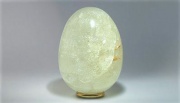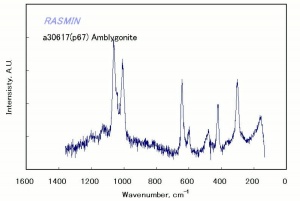Amblygonite
Description
A rare lithium containing fluorophosphate mineral that has occasionally been used as a gemstone. Amblygonite was first discovered in Saxony by A. Breithaupt in 1817. It is a translucent stone that is usually white or creamy but also occurs in pale shades of yellow, blue, gray, pink, or green. It is found in France (Montebras), Spain (Caceres), Australia, South Africa, Zimbabwe and the U.S. (Maine at Hebron, Connecticut, South Dakota in the Black Hills, California at Pala). Amblygonite is used in small amounts in some ceramic glazes. It is also used as a source for lithium.
Synonyms and Related Terms
montebrasite; hebronite; amblygoniet (Ned.); ambligonita (Esp.); Amblygonit (Deut.)
Other Properties
Triclinic system with lath-shaped crystals. Cleavage perfect in one direction and good in three other directions.
Fracture = uneven to subconchoidal. Luster = vitreous to pearly. Streak = white.
Fluorescent. Flame test = red
| Composition | (Li,Na)Al(PO4)(F,OH) |
|---|---|
| Mohs Hardness | 5.5 - 6.0 |
| Density | 3.01-3.09 |
| Refractive Index | 1.577, 1.592, 1.596 |
Additional Information
Mineralogy Database: Amblygonite
Authority
- Robert Fournier, Illustrated Dictionary of Practical Pottery, Chilton Book Company, Radnor, PA, 1992
- Van Nostrand's Scientific Encyclopedia, Douglas M. Considine (ed.), Van Nostrand Reinhold, New York, 1976
- Random House, Webster's Encyclopedic Unabridged Dictionary of the English Language, Grammercy Book, New York, 1997
- The American Heritage Dictionary or Encarta, via Microsoft Bookshelf 98, Microsoft Corp., 1998
- Encyclopedia Britannica, http://www.britannica.com Comment: "amblygonite" Encyclopædia Britannica
- C.W.Chesterman, K.E.Lowe, Audubon Society Field Guide to North American Rocks and Minerals, Alfred A. Knopf, New York, 1979
- Wikipedia, the free encyclopedia, at http://www.wikipedia.com Comment: http://en.wikipedia.org/wiki/Amblygonite; specific gravity - 2.98 - 3.11

